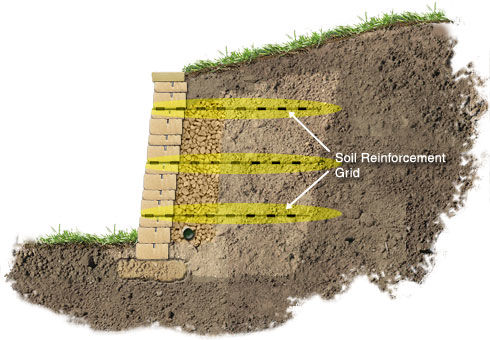There are two main types of SRWs: Unreinforced and Reinforced walls.
Each wall type has unique specifications that must be adhered to in order to ensure wall stability.
For many low walls, the weight of the VERSA-LOK units alone resists soil loads sufficiently to work as unreinforced gravity walls. The pinned-unit interlock and frictional forces between units hold the units together so the wall behaves as a coherent structure. The setback, or batter, of the wall face offers additional stability.
The maximum height of an unreinforced Mosaic wall will vary depending on soils, loading and slopes. Generally, with level backfill, good soil and no additional loading, unreinforced Mosaic walls are stable up to heights of 4 feet.
When the weight of the wall units alone is insufficient to resist soil loads, you will need to reinforce your wall. In a reinforced wall, horizontal layers of geogrid soil reinforcement stabilize the soil behind the wall units. The geogrid layers and the soil surrounding them combine to create a cohesive, reinforced soil structure (wall system) that is strong and massive enough to resist the loads exerted on it.
The type, strength and number of layers of soil reinforcement needed varies with each project depending on soils, slopes and loading conditions. A final project-specific geogrid design should be provided by a qualified professional engineer (P.E.).
Any Mosaic wall that exceeds 4 feet in height must be a reinforced wall.

Unreinforced Gravity Wall

Reinforced Retaining Wall
